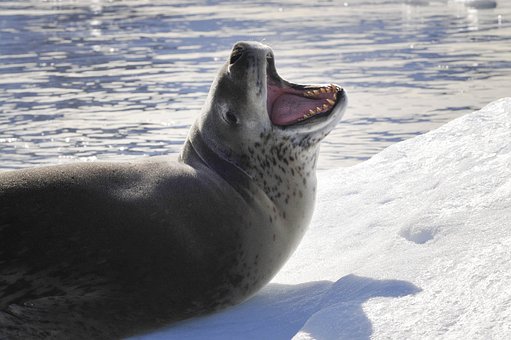
Although Antarctica doesn’t have polar bears it does have one serious predator – the Leopard seal (the females can weigh as much as an adult male polar bear and are 3-4 metres long).
These seals have a somewhat reptilian look because of the shape of their heads and the fact that their eyes are on the side of their heads rather than the front, like other seals.
Leopard seals are an opportunistic, ambush predator inhabiting the pack ice surrounding Antarctica and living solitary lives. Their diet consists of young seals, penguins, and even krill (abundant prawn-like creatures).
When they catch a penguin they smash it back and forth against the sea until the skin comes off and then eat it, so a floating penguin skin is a sign of a Leopard seal’s previous meal.
They can sometimes be found far north of Antarctica and they will eat just about anything. The Australian Antarctic Division reported that ‘One leopard seal, captured near Sydney, had eaten a fully grown platypus’.
They also have huge mouths and have been known to kill humans, though rarely. The only recorded death by a Leopard seal was at the British Antarctic Survey Rothera base in 2003. Marine biologist Kirsty Brown was attacked and killed while snorkelling.
A rescue boat team hit the seal with a shovel and it released her body but she had already drowned. Her body was recovered but resuscitation proved unsuccessful. Kirsty was only 28. Tragic.
Her parents set up a charity in her memory that funded a short-term project into the behaviour of leopard seals and a longer term geology project.
Having said that, Leopard seals don’t generally attack humans but when they do the human is often standing at the edge of the ice floe and the seals appear to mistake them for a penguin. So the lesson is – don’t stand near the edge of the ice floe!!!.
They are very curious and have been known to come up to divers but they will generally leave you alone. And the name ‘Leopard’? It comes from the markings on their undersides.
